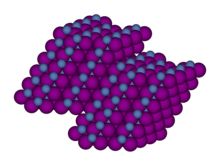
| |

| |
| Names | |
|---|---|
| IUPAC name
Nickel(II) iodide
| |
| Other names
Nickelous iodide
| |
| Identifiers | |
3D model (JSmol)
|
|
| ECHA InfoCard | 100.033.319 |
PubChem CID
|
|
| UNII | |
CompTox Dashboard (EPA)
|
|
| |
| |
| Properties | |
| I2Ni | |
| Molar mass | 312.5023 g·mol−1 |
| Appearance | iron-black solid (anhydrous) bluish-green solid (hexahydrate) |
| Density | 5.384 g/cm3 |
| Melting point | 780 °C (1,440 °F; 1,050 K) (anhydrous) 43 °C (hexahydrate, loses water) |
| 124.2 g/100 mL (0 °C) 188.2 g/100 mL (100 °C) | |
| Solubility | alcohols |
| +3875.0·10−6 cm3/mol | |
| Hazards | |
| NFPA 704 (fire diamond) | |
| Related compounds | |
Other anions
|
nickel(II) chloride, nickel(II) bromide, nickel(II) fluoride |
Other cations
|
cobalt iodide, copper iodide, |
Except where otherwise noted, data are given for materials in their standard state (at 25 °C [77 °F], 100 kPa).
| |
Nickel(II) iodide is an inorganic compound with the formula NiI2. This paramagnetic black solid dissolves readily in water to give bluish-green solutions,[1] from which crystallizes the aquo complex [Ni(H2O)6]I2 (image above).[2] This bluish-green colour is typical of hydrated nickel(II) compounds. Nickel iodides find some applications in homogeneous catalysis.

